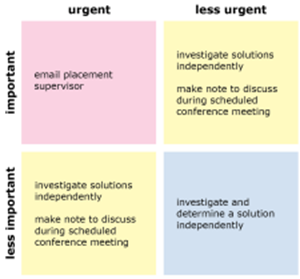Virtual Placement: Adapting to a Different Environment – Ayzel Calder
Category: New Voices
Ayzel Calder is from British Columbia, Canada. She recently completed her MSc in Information and Library Studies at Robert Gordon University; outside of her studies, she reads and writes contemporary fiction.
Virtual Placement: Adapting to a Different Environment
Benefits of a Work Placement
Rook (2015) describes work placement as an invaluable experience that provides organisations with skilled and invested individuals and students a place to research a role, develop skills, build contacts, and gain experience. It offers students enterprise awareness and helps foster professional identities through practical application of skills and observing experts (Galloway, Marks and Chillas 2014; Jackson 2017). Furthermore, work placements are most often positive learning environments with minimal barriers to learning, where students can gain new skills and develop enterprise awareness (O’Donovan 2018).
A Different Approach
Perhaps unlike in-person attending students, I fully expected my work placement to be atypical, at least in comparison to how it’s generally portrayed in general media. Due to various reasons (primarily COVID-19), I participated in Robert Gordon University’s MSc Information and Library Studies programme virtually. I had experience with virtual undergrad classes, so I wasn’t walking into the course completely unprepared or inexperienced. The placement was, as the programme was, virtual in nature. While many studies discuss the benefit of in-person work placements, where learning from observation is just as vital as learning by application (Jackson 2017), and while had it been in person, I imagine some aspects would have been different, I do not feel as though I missed out on the experience. In fact, not only was I blessed with a placement that fit right into my budding interests in information management and knowledge organisation, but as both a student and professional who thrives in independent and autonomous environments, the project and role were a perfect fit.
While I feel as though I benefitted from my chosen placement and did not miss out on the experience because it was virtual, I found I had to adapt to the situation and adopt different methods to successfully complete my assigned project. All my previous work experience has been in-person and in close contact with my supervisors and superiors. In such an environment, direct verbal communication was easy and as frequent or infrequent as necessary, where I would be able to ask questions as needed to ensure I was on the right track with assigned projects. In transitioning into a purely virtual environment, I had to strengthen my time management skills and revaluate my approaches to communication.
Tools to Success
Prior to the placement, I was quite confident in my personal skills. Working in customer service and having spent years in higher education ensured that; however, when it comes to skills, competency is directly impacted by quantity and quality of dedicated practice. I find this to be particularly true when it comes to the ability to communicate effectively and professionally. So, while I was, and remain to be, confident in my personal skills, I was determined to work on and maintain them while in my placement. Of the personal skills required for a virtual placement, communication was vital and a large, very necessary, and important part. Living in two different times zones, very little face-to-face or verbal interaction and with most communication via email had the opportunity to breed miscommunication, misunderstanding, and overall confusion. Investing energy into ensuring clear dialogue over email and advocating for the occasional meeting via video conference when necessary went a long way in ensuring both my placement supervisor and I were on the same page for the project’s duration. To ensure I did not overwhelm or ask questions that I could have answered myself, I approached my communication needs with an Eisenhower Matrix (Figure 1).
Figure 1: Eisenhower Matrix Approach
The Eisenhower Matrix helped organise my concerns and questions; by thinking critically about my questions and investing time into determining satisfactory answers autonomously, the Matrix helped prevent me from being too hasty and more independently investigative. In being forced to be more conscious of my questions and my supervisor’s time, I not only succeeded in executing the project to a high standard, but I also grew as a professional and as a more advanced communicator.
While the project highlighted my strengths in organisation, communication, and time management, it also showed where my weaknesses within those strengths lie. Professional skills should be continually developed, and to ensure I remained on the right track and keep myself accountable, I put a lot of consideration into my Personal Development Plan (PDP) throughout the placement. The PDP was instrumental in recognising pre-existing strengths and weaknesses that could potentially affect the placement project (see Table 1); in doing so, it helped develop methods to improve my strengths and combat my weaknesses.
Table 1: Partial Snapshot of the Personal Development Plan
Through Challenges Comes Growth
There are significant benefits in combining academic theory and practical application, with first hand experience demonstrating how theory could be served and utilised in a professional environment (Albrecht and Karabenick 2018). It is here, combining theory and practical experience, where academics and application merge, where I flourish. I found more positives than negatives despite the disadvantages I faced by participating in a virtual work placement. The experience still offered me the ability to apply my theoretical knowledge to a real-life scenario, to use what I knew to create an efficient and organised system that would benefit the organisation my placement was with. Participating in my placement virtually created an environment that challenged me constantly. From those challenges, I developed new skills, bettered old ones, grew as a student, and learned to adapt to new environments and be confident in them.
References:
ALBRECHT, J.R. and KARABENICK, S.A., 2018. Relevance for Learning and Motivation in Education. The Journal of experimental education. 86 (1), pp. 1–10.
GALLOWAY, L., MARKS, A., and CHILLAS, S., 2014. The Use of Internships to Foster Employability, Enterprise and Entrepreneurship in the IT Sector. Journal of Small Business and Enterprise Development. 21 (4), pp. 653–667.
JACKSON, D., 2017. Developing Pre-Professional Identity in Undergraduates Through Work Integrated Learning. Higher Education. 74 (5), pp. 833–853.
O’DONOVAN, D., 2018. Bilateral Benefits: Student Experiences of Work-Based Learning During Work Placement. Industry & Higher Education. 32 (2), pp. 119–128.
ROOK, S., 2015. Work Experience, Placements and Internships. Palgrave Macmillan.
Thank you Ayzel for sharing such helpful and insightful advice about how to make the most of a virtual placement, developing effective and efficient communications between you and your supervisor, and applying theoretical knowledge in practice as a new professional.
To read Ayzel’s earlier New Voices blog exploring why Digital Guides should be the future of academic librarianship, please click here. And if you enjoyed this New Voices blog post, why not submit your own?





